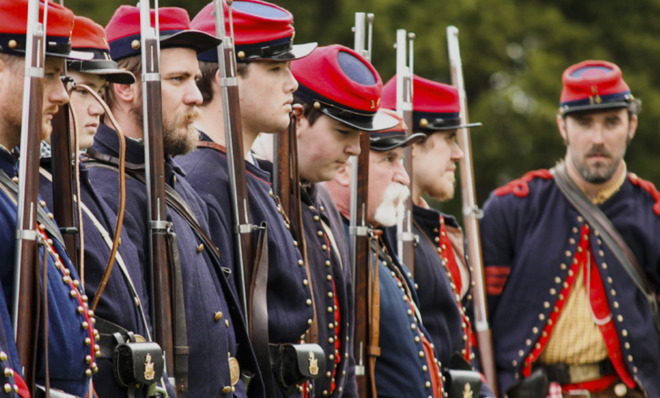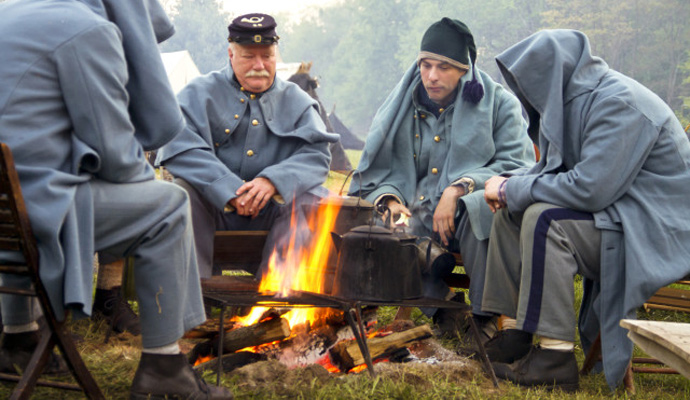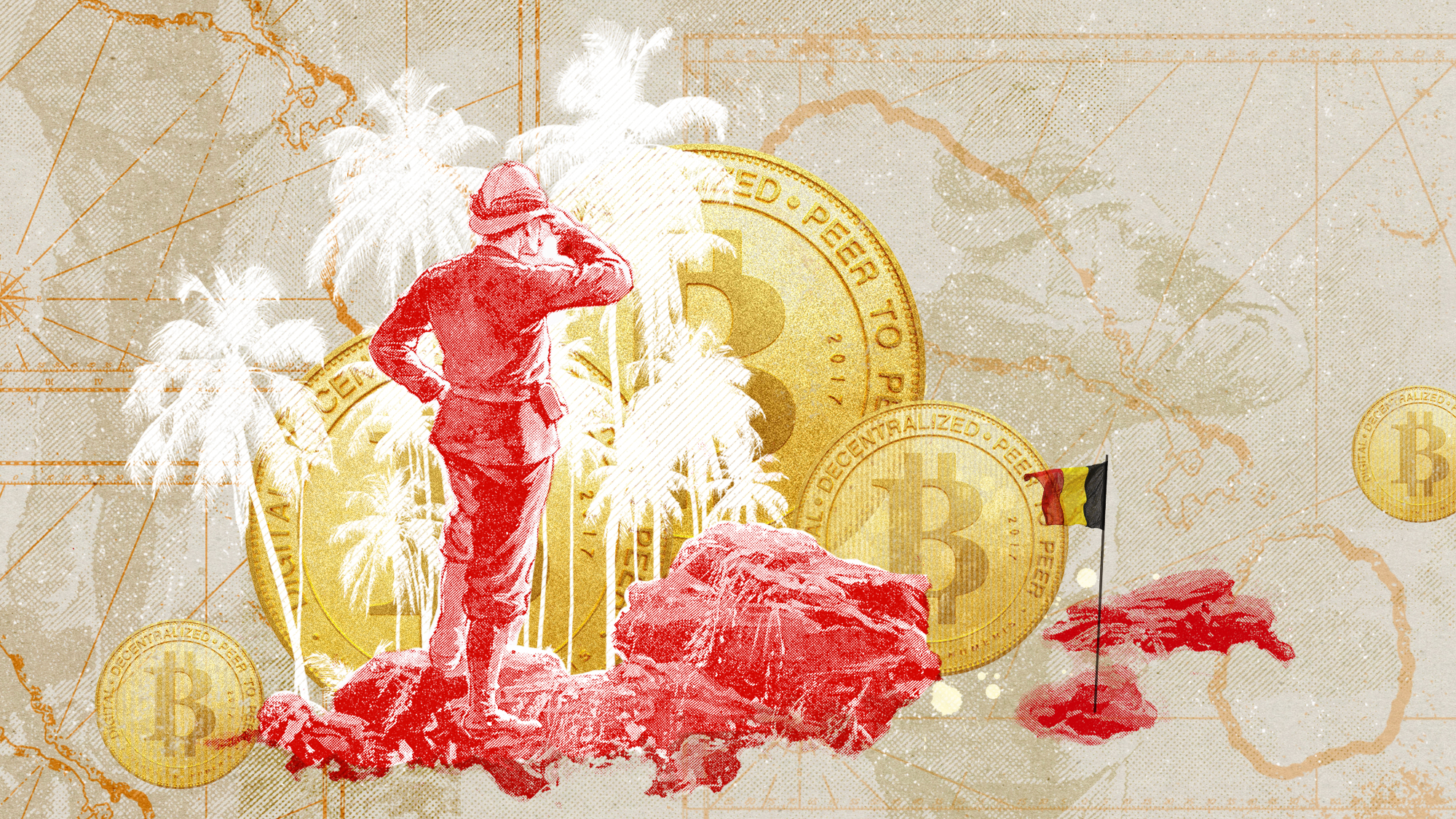The rise and fall of Civil War reenactors
There are roughly half as many as there were in 2000


Patrick Stultz wades through the forest, bushes snagging his baggy red trousers. He hoists a .58-caliber musket above his blue-wool jacket and sweat-stained red kepi hat. A rusty tin canteen rattles against the leather cartridge box on his belt. He marches out of the shadows of the elms with his fellow soldiers, blinded by the sunlight and the smoke.
Two dozen men fall clumsily into rows, stepping on one another's heels. Stultz hangs back and barks at the men of the front line to take a knee. All obey their sergeant, including Jesse Henry, a 30-year-old with whiskers like tumbleweed. He pulls out a paper cartridge and tears the flap open with his teeth. Gunpowder granules mix with saliva and turn his lower lip black. He dumps the remainder down the barrel of his replicated Springfield Model 1861 and puts a gold-colored cap no bigger than a pencil eraser in front of the hammer. Raising and aiming the 10-pound, 40-inch weapon with both hands, he pulls the trigger. Three feet of flame leap between deadened tree branches toward gray coats across the open field.
It's a Saturday in late April and a few hundred Civil War reenactors are gathered at Neshaminy State Park, a 339-acre campground northeast of Philadelphia that substitutes for Northern Virginia. There, in November and December of 1863, the Army of the Potomac tried unsuccessfully to squash the rebels before winter. Over four days of skirmishes, the Battle of Mine Run took the lives of 1,272 U.S. troops and 680 Confederates.
The Week
Escape your echo chamber. Get the facts behind the news, plus analysis from multiple perspectives.

Sign up for The Week's Free Newsletters
From our morning news briefing to a weekly Good News Newsletter, get the best of The Week delivered directly to your inbox.
From our morning news briefing to a weekly Good News Newsletter, get the best of The Week delivered directly to your inbox.
(More from Narratively: Her golden gloves)
Stultz, Henry and their fellow New York-area reenactors belong to the 14th Brooklyn Regiment Company E, which is modeled after the New York State militia whose doggedness and colorful outfits are said to have caused Confederate General Thomas "Stonewall" Jackson to shout, "Hold on, boys! Here come those red-legged devils again!"
It's an hour before the day's big battle, a public event. Hundreds of spectators are gathering on the other side of the park while the reenactors treat themselves to a "tactical" — a warm-up to make-believe. But this private moment of mock carnage and immolation would abruptly come to an end. The 14th Brooklyn has hardly volleyed shots, and got the kinks out of its formation, before they corner the enemy. Frustrated at the quick and aggressive positioning of the federals, the rebels call a cease fire about 20 minutes ahead of schedule. Brooklyn marches on.

"This sucks," Jesse Henry says. His fellow devils agree. "That was smoke-shrouded chaos. You're not going to see the elephant in that."
A free daily email with the biggest news stories of the day – and the best features from TheWeek.com
Civil War reenactors approach their hobby with the zeal of a prophet and the curiosity of an academic. On the battlefield they live to "see the elephant," a nineteenth-century phrase describing the rush that only certain daring pursuits — exploration, hunting or war — can provide. Those moments, however, are becoming fewer and far between. The old guys are getting out of the game and, although it's a young man's hobby, the kids aren't necessarily rushing to take their place. What was considered hardcore only a couple decades ago is now looked down upon. Meanwhile, the Great Recession has taken its toll on what was already an expensive endeavor. Time, in this case, may not be on their side. Their numbers have dropped significantly in the last 15 years and may never return.
They see themselves not as the gun nuts and losers that popular culture would have you believe, but as teachers, the self-anointed and self-effacing stewards of our nation's past. And to save that past — or rather, future — the 14th Brooklyn and their allies are leading the charge to do two seemingly irreconcilable things: make the hobby more appealing and yet more absolute.
And yet there may be a silver lining in the hobby's decline. Those members of a group or a movement who stick through it in good times and in bad are often the most devout.
(More from Narratively: Zen and the art of whip cracking)
The earliest Civil War reenactors were in fact Civil War soldiers. Before the fighting ended, veterans were already restaging battles to honor the dead and to show civilians what their countrymen had endured. Over the next 100 years, recreations were performed mostly by service men, as had been the tradition of some armies going back to ancient Rome. However, during centennial commemorations in the early 1960s, the federal government decided it was disrespectful to let people shoot at each other and pretend to die where others had actually died.
The void was filled by ordinary men who held reenactments off-site, sometimes on fields adjacent to hallowed ground. They marched in work shirts, gray-colored jeans and cowboy boots. Cartridge boxes were constructed out of cardboard. Instead of a musket, some brought muzzle loading shotguns.
"People realized that wasn't a good representation [of a soldier]," says Robert Lee Hadden, 62, the author of Reliving the Civil War: A Reenactor's Handbook.
A few groups, he says, began obsessing over details as early as the late 1960s, some of whose members turned up with original Civil War accoutrements. But the push towards more period-authentic dress came about a decade later, and has intensified since then. As the hobby evolved, so too did a marketplace for proper-looking gear.

It wasn't until the late 1970s and '80s, on the heels of the country's bicentennial celebrations, that the numbers of the fake ranks exploded. In 1986, Time magazine estimated there were as many as 50,000 Civil War reenactors throughout the country. Relying on the registration lists of bigger events, some long-term veterans of the hobby say their numbers held steady until about 2000. Today they're about half the size.
The quick decline has caused many reenactors to reevaluate how the hobby is run, and by whom, in an effort to preserve it. One sore spot is Gettysburg, which has been organized for the last 18 years by the Gettysburg Anniversary Committee (GAC), a for-profit company. This summer was the 150th anniversary of that decisive battle, but thousands of reenactors didn't go. Many of them claim the event has been overrun by the worst of what the hobby has to offer — the poseurs and profiteers. Their solution? Secede.
In June, the 14th Brooklyn participated in a different Gettysburg event hosted by the Blue Gray Alliance (BGA), a non-profit network of hundreds of reenactment groups from both North and South. They charged less and promised to put the needs of the men above money. They did away with GAC practices like providing bleacher seats for those spectators willing to pay a little more. It's a serious distraction, they say, when your goal is to relive, and consecrate, a moment from rural Pennsylvania, 1863.
"It's almost like a sporting event rather than a reenactment," says Terry Shelton, the BGA's Confederate commander, "and that's why reenactors have stopped going to that event. It's so commercialized."
Each group claims to have attracted more than 10,000 reenactors to their own Gettysburg event; there were likely some men who went to both. One major difference between the two was that the BGA managed to recreate several clashes as they had actually occurred, in real time.
(More from Narratively: The brutal honesty of a bloodsport baron)
During the many months it took to plot troop movements, Shelton's man in charge of artillery dug through official reports as well as firsthand accounts and produced a paper about Pickett's Charge, the final and futile assault of the battle. He found that Confederate artillerymen should have been spread across the field, whereas the men who organized Gettysburg for many years had been deploying them in a straight line. Shelton was startled. Put a couple cannons in the wrong place, he says, and you've changed the complexion of the whole performance.
The BGA event was not without its own problems, namely a shortage of water in at least one part of the campgrounds. (No event is immune to criticism, and that includes Neshaminy, which is run by a committee of reenactors, locals and park rangers.) Shelton dismisses complaints of the accommodations as the grumbling of a fastidious few. Put some reenactors in a time machine, back to the war, he says, "and they'd still be unhappy."
Next summer, it's likely the GAC will resume its monopoly over the Gettysburg commemoration. Shelton says he doubts the BGA will have the energy to put on an event that is bound to attract far fewer people. The 150th anniversary was a milestone. The 151st, not so much.
In June, Peter Carmichael, a professor of history at Gettysburg College, told the Wall Street Journal that reenactments were an "unfortunate distraction." To understand history and its reverberations on our modern politics, he said, one must hold a musket and taste period-authentic food in addition to reading classroom texts. In other words, war is not a spectator sport.
Read more of this story at Narratively.
Narratively is an online magazine devoted to original, in-depth and untold stories. Each week, Narratively explores a different theme and publishes just one story a day. It was one of TIME's 50 Best Websites of 2013.
-
 Critics’ choice: The year’s top 10 movies
Critics’ choice: The year’s top 10 moviesFeature ‘One Battle After Another’ and ‘It Was Just an Accident’ stand out
-
 The small Caribbean island courting crypto billions
The small Caribbean island courting crypto billionsUnder the Radar Crypto mogul Olivier Janssens plans to create a libertarian utopia on Nevis
-
 Political cartoons for December 21
Political cartoons for December 21Cartoons Sunday’s political cartoons include Christmas movies, AI sermons, and more